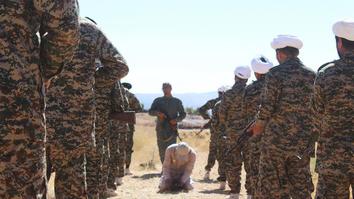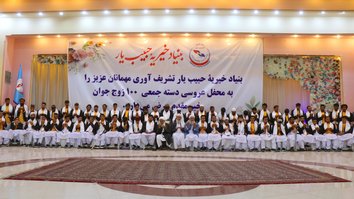HERAT -- With the war in Syria drawing down, the Iranian regime is sending members of its Fatemiyoun Division to Afghanistan hidden among refugees in a bid to stoke religious conflict in the country, officials say.
The Iranian government secretly sends a number of Fatemiyoun fighters every day to Herat Province disguised as refugees, a National Directorate of Security (NDS) official told Salaam Times on the condition of anonymity.
The fighters, originally sent to fight for Syrian President Bashar al-Assad's regime, were recruited by the Islamic Revolutionary Guard Corps (IRGC) from communities of Afghan refugees and migrants living inside Iran.
"After Iran used Fatemiyoun fighters in Syria ... it has now decided to benefit from them by pursuing its political and military goals in Afghanistan," he said.
![Fatemiyoun fighters seen here being made to watch a speech by Iran's Supreme Leader Ayatollah Khamenei in early May. Many of these fighters, now that the war in Syria is winding down, are being sent back into Afghanistan. [File]](/cnmi_st/images/2019/06/11/18275-fatemiyoun-585_329.jpg)
Fatemiyoun fighters seen here being made to watch a speech by Iran's Supreme Leader Ayatollah Khamenei in early May. Many of these fighters, now that the war in Syria is winding down, are being sent back into Afghanistan. [File]
![More than 400 residents of Herat, including women, civil society activists and religious scholars, condemned the transfer of such fighters in a gathering May 22 in Herat City, Herat Province. [Omar]](/cnmi_st/images/2019/06/11/18269-f_1-585_329.jpg)
More than 400 residents of Herat, including women, civil society activists and religious scholars, condemned the transfer of such fighters in a gathering May 22 in Herat City, Herat Province. [Omar]
By not dissolving the Fatemiyoun Division, the Iranian regime intends to use those troops to ignite sectarian conflict in Afghanistan, he added.
"Members of the Fatemiyoun Division have received military training, and they could be very dangerous for Afghanistan," the official said. "These individuals can cause grave security problems in Afghanistan, especially in Herat Province."
The long arm of Tehran apparently made itself felt when Muhammad Ibrahim, an Iranian religious scholar and dissident who fled his homeland and took refuge in Herat Province, was seriously injured by unknown individuals May 17 in Herat. He died of his wounds May 22, according to the official.
Ibrahim, besides opposing the Iranian regime, belonged to his country's oppressed Sunni minority.
Credible sources have indicated that the Iranian scholar was killed by members of the Fatemiyoun Division, added the NDS official, though authorities have not made any arrests yet.
"The Afghan government implements strict measures with regards to Fatemiyoun fighters and apprehends them. We have identified and arrested two Fatemiyoun members in the past few days and sent them to prison," said the official, without providing more details.
Citizens' concern
Afghans have raised concerns about Fatemiyoun members whom the Iranian regime sent back to Afghanistan.
More than 400 residents of Herat, including women, civil society activists and religious scholars, condemned the transfer of such fighters during a gathering on May 22 in the Ghazi Amanullah Khan auditorium in Herat city.
"The Fatemiyoun Division is a group that Iran has trained for the Syrian war," said Sameha Ahmadi, a civil society activist in Herat.
"If it comes to Afghanistan and joins the Taliban, it will be very threatening," she said.
The Fatemiyoun Division and the Taliban are the same, according to Ahmadi.
"We always fall victim to the evil goals of our neighbouring countries, and these countries use our youth as weapons," she added.
"We call upon the Afghan government and the international community to look hard into the transfer of Fatemiyoun members to Afghanistan," she said.
"The transfer of various anti-government groups, especially the Fatemiyoun," has alarmed the public, said Omaid Naab, another civil society activist in Herat.
"Unfortunately, if the transfer of this group into Afghanistan continues, our country could engage in [another] war that could destroy our people," Naab said.
Pursuing Tehran's goals
"The returnees from Iran to Afghanistan, especially those who were recruited by Iran to fight proxy wars in the region, are a matter of grave concern," said Fatema Jafari, a member of the Herat Provincial Council.
Fatemiyoun members lack skills other than fighting and have no income from any other sources either, she said.
"As jobs are scarce in Afghanistan, they can be transformed into opportunist and irresponsible [armed] groups that could cause many problems," she added.
"The government and its security ministries must employ strict measures to control Fatemiyoun fighters who are returning to the country," Jafari said.
The Iranian regime views Afghan refugees as weapons, said Abdul Qader Kamel, a political affairs analyst in Herat city.
"We all know that the IRGC sent thousands of our refugee countrymen to the war in Syria and other countries in the region as part of the Fatemiyoun Division, and a large number of them were killed," he said. "Many of their bodies were not given to their families."
"The government of Iran uses the Fatemiyoun for its proxy wars," Kamel said, adding that the Iranian regime certainly might use Fatemiyoun members against US and Afghan forces.
"Iran's continued interference in Afghanistan's internal matters through the Fatemiyoun Division could degrade relations between the two countries,"he said. "Afghans' trust in Iran has hit its all-time low."








We are for you Allah the almighty We are for you messenger of Allah We are for you Emir of the faithful Ali-ibn- Abitalib We are for you Hujjat ibn Al-Hasan (may our souls be sacrificed for him), We are for you Khamenei (may Allah keep him safe) Long live the government of Islamic Republic of Iran and long live Fatemioun Division.
Reply14 Comment
The Fatemiyoun's lion-cabs went to Syria on their own free will to defend from their beliefs, and they are never dangerous to Afghanistan. Some people are better think about fighting with ISIS terrorism, instead of worrying about the presence of the brave youths in the country. If these lions were not there, ISIS would have occupied Afghanistan after holding its foothold in Syria and Iraq.
ReplyISIS is a tool to destroy Syria and it can do nothing without the assistance of the West.
ReplyMr. or Madam Salaam Times,
ReplyPlease inform the Fatemiyoun soldiers that after all they are Afghans and Afghanistan has a lot of problems, and as Afghan, they should neither sell their country nor be mercenaries of the enemies of Afghanistan.
14 Comment
Abdul Qader Kamel is the slave and laborer of America and he tells lie. Holy Shrine Defenders are recruited arbitrarily, not compulsorily. No one has forced the members of Fatemiyoun and Zainabiyoun and even the Quds who are Iranian to fight against ISIS. Fatemiyoun are Shia. Your media outlet is potentially related to America.
ReplyIt is not a matter of choice or compulsion. Fighters of Fatemiyoun division are brainwashed the same as the ISIS fighters are
Reply14 Comment
ya it was good but....
Reply14 Comment
The United States itself is a terrorist, and seeking help from terrorists is the act of stupid individuals. Despite some actions by Fatemiyoun inside Afghanistan, we will not allow them to secure the interests of other countries! In a nutshell, the United States and the West themselves are our challenges. P
Reply14 Comment
You screw up for becoming an ISIS and/or Taliban member ... You haven't done a thing!
Reply14 Comment
I'm perplexed as to why a number of Afghans who were fighting on behalf of the ISIS in Syria have never been considered as a threat to the interests of Afghanistan and have never been viewed as a source of concern for Afghanistan's civil society and government. The Fatemiyoun group will never fight on behalf, or on the side, of the Taliban, even if they are asked by the government of Iran.
Reply14 Comment
It was so ridiculous, because Fatemiyoun are anti-Taliban!
Reply14 Comment
This is nonsense! The part of the article where its argued that the joining to the Taliban by the Fatemiyoun forces could be very dangerous, was super interesting. The fact of the matter is, however, that the two have nothing in common. The Taliban are mercenaries and spies of the West and the Zionism, while Fatemiyoun fight under the banner of the Prophet's Household, and are supported by a Shi'i country. The Taliban, however, are murdering the Shi'as. And now (you say) that Fatemiyoun members are going to join the Taliban! What a load of rubbish!
Reply14 Comment
The government of Afghanistan should quarantine those Hazaras and other Shias who fought in Syria in favor of Iran upon their return to Afghanistan, brainwash them and give them patriotic lessons. Then they may evaluate them, those who have come back on the track, they may let them reintegrate in the society, while those have not come to the right path, they may return them back to Iran or put them in jail forever because there is no difference among them, Taliban and ISIS militants. Taliban and ISIS are used by Pakistan, while Fatemiyoun are used by Iran against Afghanistan.
ReplyYou may better give medals of honor to the Afghans who fought for ISIS in Syria!
Reply14 Comment